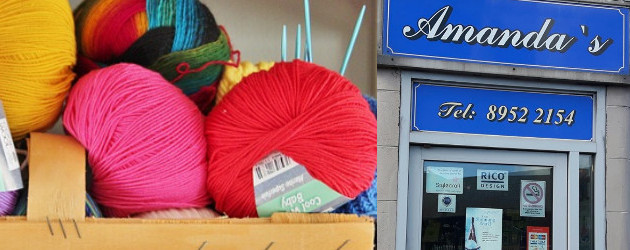Amanda’s Wool & Craft Shop Craft Shop in Fivemiletown
Family run wool and craft shop, selling a large range of wool and fabrics, haberdashery and much more. We also sell bed linen, duvets and towels
137-139 Main Street
Fivemiletown
County Tyrone
BT75 0PG
T: 028 8952 2154

Wool’s scaling and crimp make it easier to spin the fleece by helping the individual fibers attach to each other, so they stay together. Because of the crimp, wool fabrics have greater bulk than other textiles, and they hold air, which causes the fabric to retain heat. Wool has a high specific heat coefficient, so it impedes heat transfer in general. This effect has benefited desert peoples, as Bedouins and Tuaregs use wool clothes for insulation.
Felting of wool occurs upon hammering or other mechanical agitation as the microscopic barbs on the surface of wool fibers hook together.
The amount of crimp corresponds to the fineness of the wool fibers. A fine wool like Merino may have up to 100 crimps per inch, while the coarser wools like karakul may have as few as one or two. In contrast, hair has little if any scale and no crimp, and little ability to bind into yarn. On sheep, the hair part of the fleece is called kemp. The relative amounts of kemp to wool vary from breed to breed and make some fleeces more desirable for spinning, felting, or carding into batts for quilts or other insulating products, including the famous tweed cloth of Scotland.
Wool fibers readily absorb moisture, but are not hollow. Wool can absorb almost one-third of its own weight in water. Wool absorbs sound like many other fabrics. It is generally a creamy white color, although some breeds of sheep produce natural colors, such as black, brown, silver, and random mixes.
Wool ignites at a higher temperature than cotton and some synthetic fibers. It has a lower rate of flame spread, a lower rate of heat release, a lower heat of combustion, and does not melt or drip; it forms a char which is insulating and self-extinguishing, and it contributes less to toxic gases and smoke than other flooring products when used in carpets. Wool carpets are specified for high safety environments, such as trains and aircraft. Wool is usually specified for garments for firefighters, soldiers, and others in occupations where they are exposed to the likelihood of fire.
Wool is considered by the medical profession to be allergenic.








